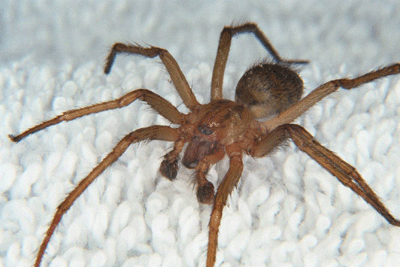SERVICE REQUEST?
Fill out the form below.
Find our nearest location
Your Local Office

Hobo Spider
Attribution: Dr. Lee Ostrom, from Wikimedia Commons
Size:
Measures up to 3/4-inch in length and has a leg span measuring more than one and a half inches.
Color:
Brownish gray with a number of various markings.
Behavior:
Hobo spiders are funnel-web spiders, meaning they construct flat webs which have a funnel-shaped retreat at one end. The females spend most of their lives in the webs while the males and immature spiders may wander about in search of females or better nesting sites. If a spider should wander into shoes, clothing or beneath covers, it puts itself into potential contact with people. If a person accidentally traps the spider against his or her skin, the spider bites out of defensive reflex. Unfortunately, the hobo spider’s bite may result in an ulcerating wound similar to that of the brown recluse spider. Allowing the bite to become infected only increases the potential skin damage. Any person receiving any perceived spider bite should consult a physician for treatment.
The hobo spider is found only in the Pacific Northwest in Washington, Idaho and Oregon. This species prefers to build its webs where a hole or crack exists in which it can locate its funnel retreat. Such webs are usually found in basements, crawl spaces, garages and outdoors in vegetation.
The key to controlling the hobo spider is to look for webs and remove them, making sure a treatment is applied into any crack associated with the web. This spider is a serious enough pest that a professional should be consulted to conduct a thorough inspection and possible treatments. Recommended steps to be taken to prevent new spiders from entering, include:
- Removing or limiting heavy, ground-covering vegetation near the building.
- Sealing cracks and holes in the building’s exterior.
- Installing tight-fitting screens on all attic and foundation vents.
- Sealing holes around pipes indoors to prevent spiders from entering the living spaces of the home from basements and crawl spaces by following plumbing lines.
Bites may be prevented in homes where this spider has been found (and until they are controlled) by implementing the following steps:
- Remove any bed skirts and bed linens, covers, etc. that might touch the floor and allow spiders to crawl onto the bed.
- Pull beds away from walls and curtains.
- Do not store clothing on the floor or beneath beds where spiders might easily crawl into them.
- Store shoes in boxes with tight-fitting lids.
- Shake clothing and shoes vigorously prior to putting them on.
- Check under the sheets and covers before climbing into bed.
Family Name:
Tegenaria agrestis
Read What Our Clients
Are Saying
My Terminix tech Scott is the best! He is professional, courteous and absolutely thorough about his job. Thank you for sending such a blessed tech to my house. Hamlet, NC
This letter is to say how pleased we are here at Morreene West Apartments with your services. We are very pleased with the technician, Christopher. He does a great job. Durham, NC
Terminix has consistently offered our apartment complex reliable, competent service. We are completely satisfied with their knowledgeable representative who is always punctual and does a superior job for us every time. Chapel Hill, NC
I would like to take the time to thank you for giving us such great service here at Carver Pond Apartments. Your Pest Technician Christopher Mitchell has provided us with excellent service over the last few months. Christopher is such a great help to us in providing helpful information so that we can better serve our residents here at Carver Pond. Durham, NC
SERVICE REQUEST?
Fill out the form below.